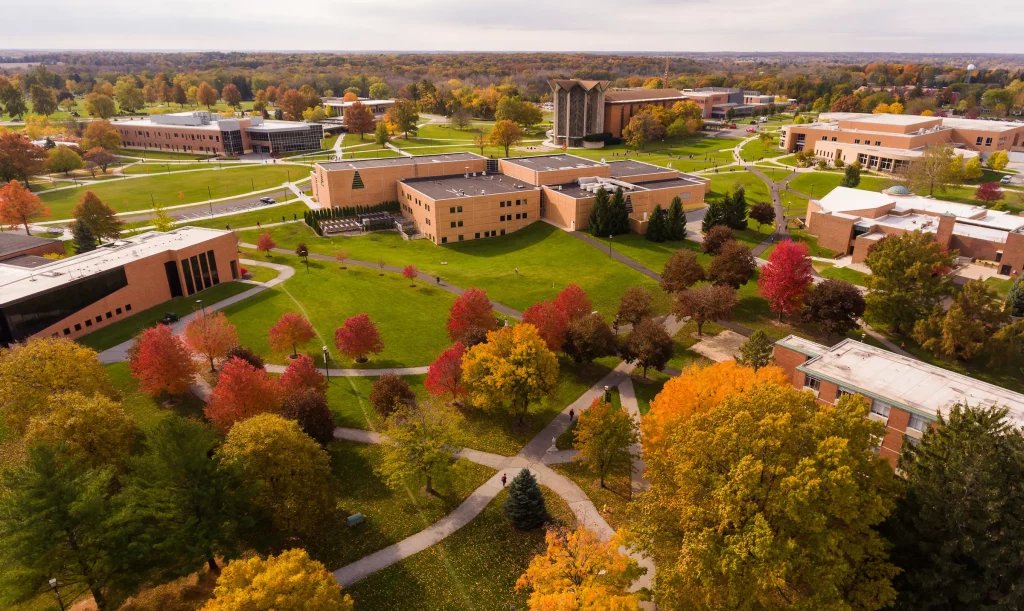Engineering the Future of Transportation Research
The College of Engineering strives to offer a wide range of research opportunities to fuel the creative curiosity of Valpo’s future engineers. The College allows independent study to advance student research skills and allow them to build the qualities that employers look for in today’s job market. The transportation research team is living up to the Valpo standard of excellence by putting their research into practice right here on campus as university officials look to them for recommendations about University parking and traffic accommodations.
“At Valpo, we can tailor student interests to a specific area of research,” Jay Grossman, assistant professor of civil engineering, says. “The transportation research team really has several areas of study that students can choose from, and it all depends on what they want to do.”
The opportunity that is set forth for students is one that allows them to start thinking about what they would like to pursue and adjust course based on their findings.
“About a year and a half ago, the dean bought a drone that helps us in conducting our parking study for the University, which is basically looking at parking on campus and pointing out where we need more, where we can adjust and where we can cut back,” Professor Grossman says. “Last year, behind Guild/Memorial Hall, there was a lot of commuter parking that was not being used and they switched it over to more residential spots based on the research that we presented to them.”
While students are making a noticeable difference on campus with their research, their work off-campus is also putting them on the map. Civil engineering major Carly Schiene ’24 created a model intersection for a local highway department and presented research to aid in the approval of a new construction project.
“This past semester, I researched the efficiency of a peanut intersection for the Elkhart County Highway Department,” Carly says. “For this project, my main task was to model the intersection with data that was already collected. I used the program VISSIM — which I had never used before — to create models of the current and proposed intersections and measure the effectiveness of each. We then used these simulations to show the Finance Committee and Town Council how the peanut intersection operates so it could be built. It was a great learning experience to understand more about a program I will potentially use in my future career.”
Carly’s work on the model intersection brought the data to life and allowed officials to visualize what the project could look like and how it would operate. This crucial step of the planning process became the catalyst that propelled it forward into approved construction.
“The traffic modeling work that Carly completed was a key component of a public presentation for a federally funded roundabout project in Elkhart County,” Charles McKenzie, project engineer, Elkhart County Highway says. “Carly was able to determine our needs for the model over a series of short discussions, and delivered a product that was heavily utilized in meetings with elected officials and the public. When observing elected officials viewing the traffic model, it was evident that a picture is worth a thousand words. As a result, the project was green lit by Elkhart County officials and will be constructed in 2023-2024.
”The College of Engineering is providing students with real-world experience and vital field exposure that puts them in a position to make a real impact. And like Carly, civil engineering major Evan Stock ‘23 took advantage of those resources and found himself working on a research project for the city of Chicago.
“My research has been primarily focused on measuring the effectiveness of pedestrian safety measures in Chicago,” Evan says. “I watched hours of film — primarily cars making right and left turns — and recorded their interactions with pedestrians at locations with curb bump-outs or marked lanes to see if they used more or less caution with new variables. I then analyzed the data to find the most common turning radii, the most dangerous times of day, and other valuable information that helped the city determine their next plan of action.”
Professor Grossman explains that students spend hours in class and through independent study learning the basics of how to research, gather data, and utilize their findings to present meaningful results. And though their research projects are mostly independent, Professor Grossman gives them the support and guidance they need to achieve their targeted goals.
“Professor Grossman is a very knowledgeable and selfless individual, and I have learned more than I can express from him,” Carly says. “He always puts others before himself and is a very kind and understanding person. His knowledge of transportation is immense, and he has given me and everyone on the team every opportunity to advance our careers and education in transportation.”
The transportation research team is an essential part of the Valpo engineering student experience, and the work that they accomplish serves to move our University forward, while catering to individual student interests in the field. The skillset they build through participation in the team allows them to be more marketable in the workplace, well rounded for graduate school, and ready to accomplish the first step of their professional lives.
“Working with Professor Grossman and his experience allows me to see problems and correlations from new angles,” Evan says. “Whenever I am stumped, he helps me either come to the answer or, in the rare case that he doesn’t know it, find the right place to look for it. I’ve received guidance on research, classes, friendships, and more, and I think all of it has been beneficial to my growth as an individual both now and later.”

